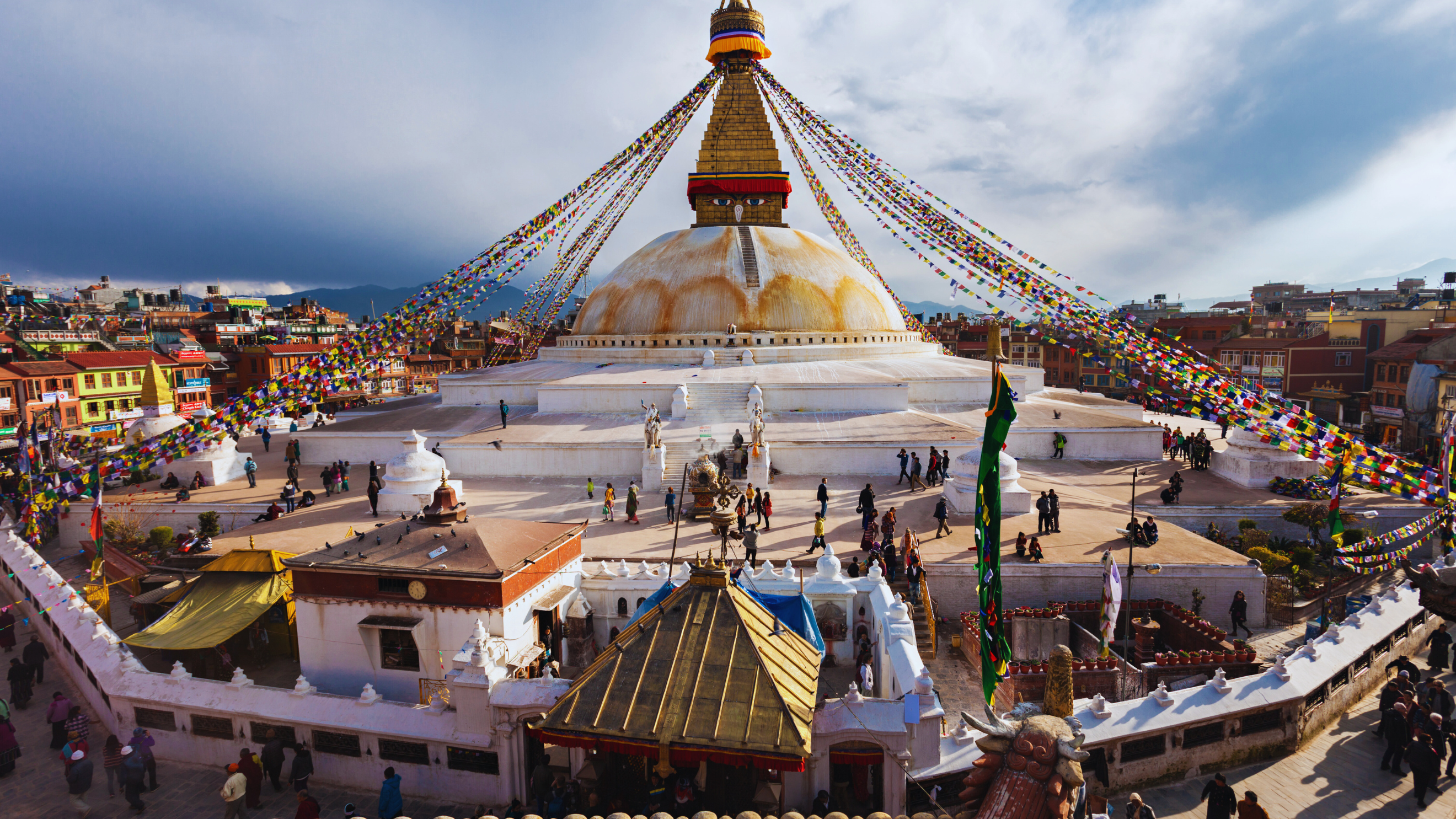
World Heritage Sites of Kathmandu Valley are home to seven UNESCO World Heritage Sites, each a unique window into the rich cultural and historic heritage of Nepal. It encompasses the ancient Kathmandu Durbar Square, the heart of royal architecture and history; Swayambhunath Stupa, also known as the Monkey Temple, a holy Buddhist pilgrimage site commanding a panoramic view of the valley; and Pashupatinath Temple, a sacred Hindu temple dedicated to Lord Shiva, best known for its spiritual significance and beautiful pagoda architecture.
Others include Boudhanath Stupa, one of the largest Buddhist stupas in the world, surrounded by vibrant Tibetan monasteries. It also includes Patan Durbar Square, which is known for its intricate Newar architecture and art; Bhaktapur Durbar Square, a well-preserved medieval city that epitomizes temples and palaces; and lastly, the ancient city of Changu Narayan with its Hindu temples and inscriptions.
Together, these sites represent the artistic, religious, and architectural heritage of the Kathmandu Valley and therefore constitute a cultural treasure trove for visitors.
Kathmandu Durbar Square
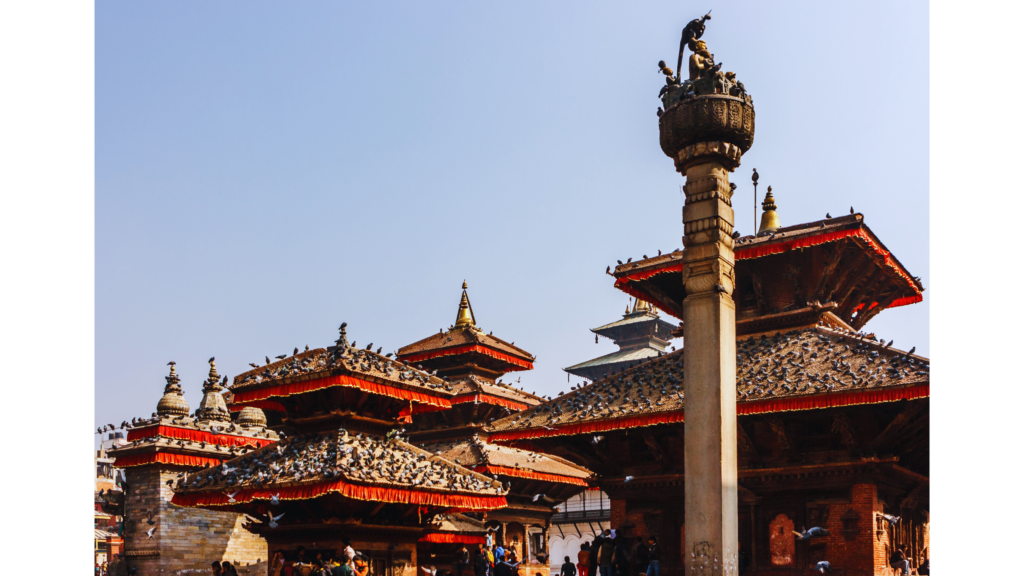
Kathmandu Durbar Square, located in the heart of Nepal’s capital, Kathmandu, is a historical and cultural gem, showcasing the magnificent architecture and rich history of the Malla and Shah dynasties. This UNESCO World Heritage Site consists of a complex of palaces, courtyards, and temples, which served as the royal residence and cultural center for centuries.
The square is known for its intricate woodwork, stone sculptures, and elaborate buildings. Some prominent structures include the Hanuman Dhoka Palace, which was once the royal palace of Nepalese kings; the Kumari Ghar, home to the Living Goddess, Kumari; and various temples dedicated to deities such as Taleju, Shiva, and Krishna. Each temple reflects traditional Newari architectural styles, often featuring multi-tiered pagoda roofs, finely carved windows, and statues that embody the skills of local artisans.
Kathmandu Durbar Square is also a vibrant public space where visitors can observe local life, festivals, and cultural events. It has withstood the test of time and the 2015 earthquake, though parts of it are still being restored. The square remains a popular attraction for its historical significance and as a center for Nepalese art and culture.
Swayambhunath
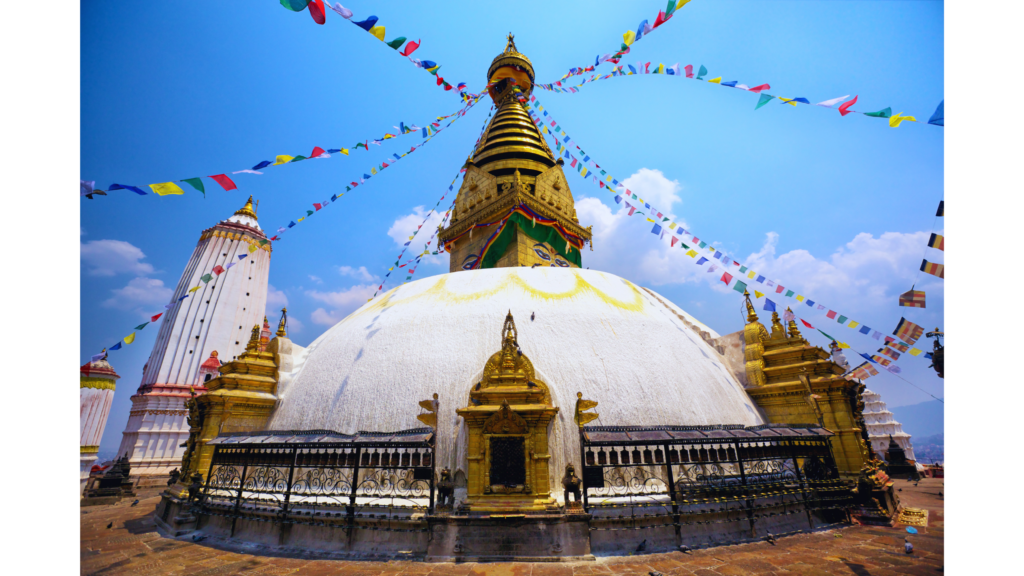
Swayambhunath, also known as the Monkey Temple, is one of the most sacred and iconic Buddhist pilgrimage sites in Nepal. Located on a hilltop in Kathmandu Valley, this ancient stupa is not only a place of worship but also a symbol of Nepal’s rich cultural heritage. It is said to be over 2,500 years old, making it one of the oldest religious monuments in Nepal.
The stupa features a white dome and a gilded spire, which is crowned with a pair of Buddha’s all-seeing eyes that represent wisdom and compassion. The spire is adorned with prayer flags and intricate carvings, and the base of the dome is surrounded by shrines and statues. The site provides a panoramic view of Kathmandu Valley, making it popular among both pilgrims and tourists.
Known as the Monkey Temple due to the large population of monkeys residing there, Swayambhunath is revered by both Buddhists and Hindus, showcasing the religious harmony in Nepal. The ambiance is often filled with the sound of prayer wheels spinning, the scent of incense, and the flutter of prayer flags in the wind, creating a serene and spiritual atmosphere that draws visitors from around the world.
Bhaktapur Durbar Square
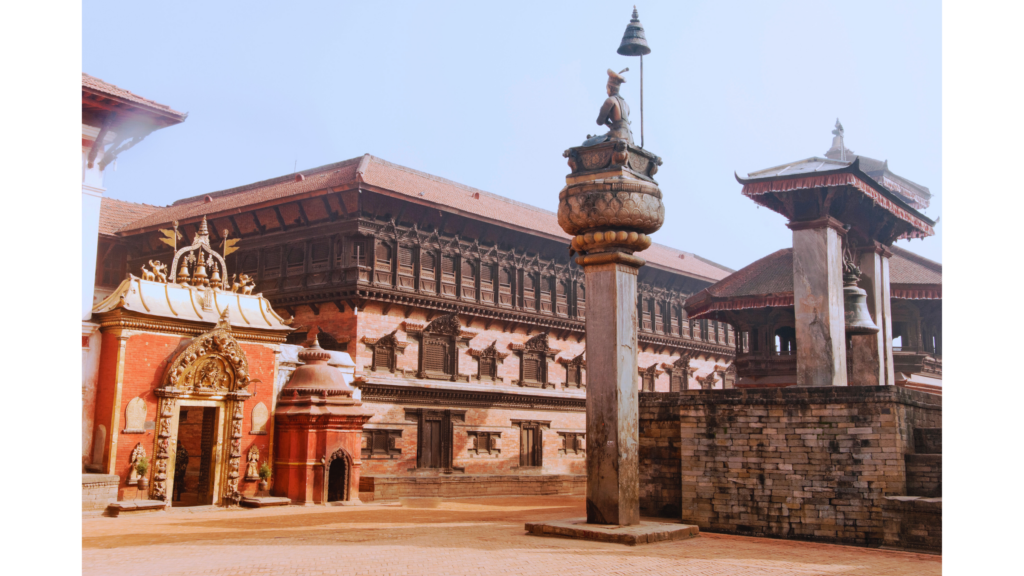
The Bhaktapur Durbar Square in the historic city of Bhaktapur is one of the UNESCO World Heritage Sites that depicts the beautiful artistry, culture, and architecture of the Malla period. The royal palace complex has this historical place surrounded by beautifully crafted temples and wood and stone accents within a portion of the vast monument. The palace of fifty-five windows has some finely carved doors and windows. The dominant feature of the square is the magnificent five-story Nyatapola Temple dedicated to goddess Siddhi Lakshmi, the tallest pagoda-style temple in Nepal. Vatsala Temple, which is characterized by ornate stone sculpture work, and Bhairabnath Temple, which is dedicated to a ferocious cell of Lord Shiva, add life to the square. Located at the heart of the city, Bhaktapur Durbar Square is the center stage of Bisket Jatra, Dasain, and other festivals where native people perform the aged dances, cultures, traditions, and celebrations.
Though the area was greatly impacted by the earthquake of 2015, various restoration packages have helped retain its architectural beauty, and it remains a major draw for visitors and an icon representing the culture of the country. The experience of the Bhaktapur Durbar Square enables people to taste the beauty and history of Nepal, and that is why it is an attraction of the encyclopaedic people who wish to appreciate the splendor and culture of the place.
Patan Durbar Square

Patan Durbar Square, located in the heart of Lalitpur, Nepal, is a UNESCO World Heritage Site celebrated for its breathtaking Newar architecture and artistic legacy. Once the royal palace complex of the Malla kings, the square is adorned with intricate temples, courtyards, and statues that reflect the rich cultural history of Nepal. Among its highlights are the Krishna Mandir, a magnificent temple made of stone and dedicated to Lord Krishna, and the Bhimsen Temple, known for its stunning golden facade and dedication to the god of trade and commerce.
The palace itself, with its impressive wood-carved windows, doorways, and elaborate carvings, is a masterpiece of traditional craftsmanship.
The Patan Museum, housed within the palace, exhibits a remarkable collection of art and artifacts from Nepal’s Hindu and Buddhist traditions, offering visitors a deeper understanding of Nepalese spirituality and artistry. Patan Durbar Square is also the center for cultural festivals like Rato Machhindranath Jatra, celebrated with vibrant processions and rituals. This site is a captivating blend of art, religion, and history, making it an essential destination for those exploring Nepal’s heritage.
Boudhanath
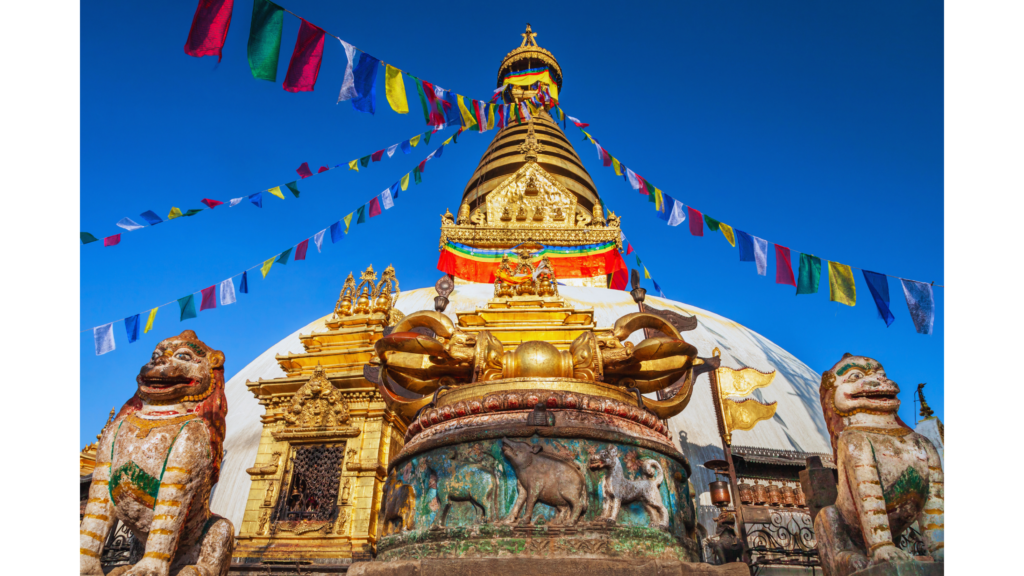
Boudhanath, in the Kathmandu of Nepal, is a heritage site in the world listed as a UNESCO site and is also regarded as one of the paramount stupas in the whole world.
Boudhanath, and its widely known immense white dome are topped by a gleaming gold spire, which attracts Buddhists from Nepal, Tibet, and other parts of the world. The stupa is said to be built over the purported remains of Buddha, which hold so much presumed meaning, as even construction elements of the stupa portray attributes of the enlightenment process.
The eyes of the Buddha are also painted on the four sides of the stupa and represent wise and caring visions that dive above humanity. Boudhanath is a rich place economically and spiritually given that it is flanked by monasteries, stores, eating places, and other places for cultural and spiritual activities.
There are flickering butter lamps offered by devotees, and throngs of prayers are sounded in the background as Tibetans chant while they undertake circumambulation.
Other than devotion and recollection of Buddhist beliefs, a visit to Boudhanath makes a person enriched with Kathmandu’s past and traditions.
Changunarayan
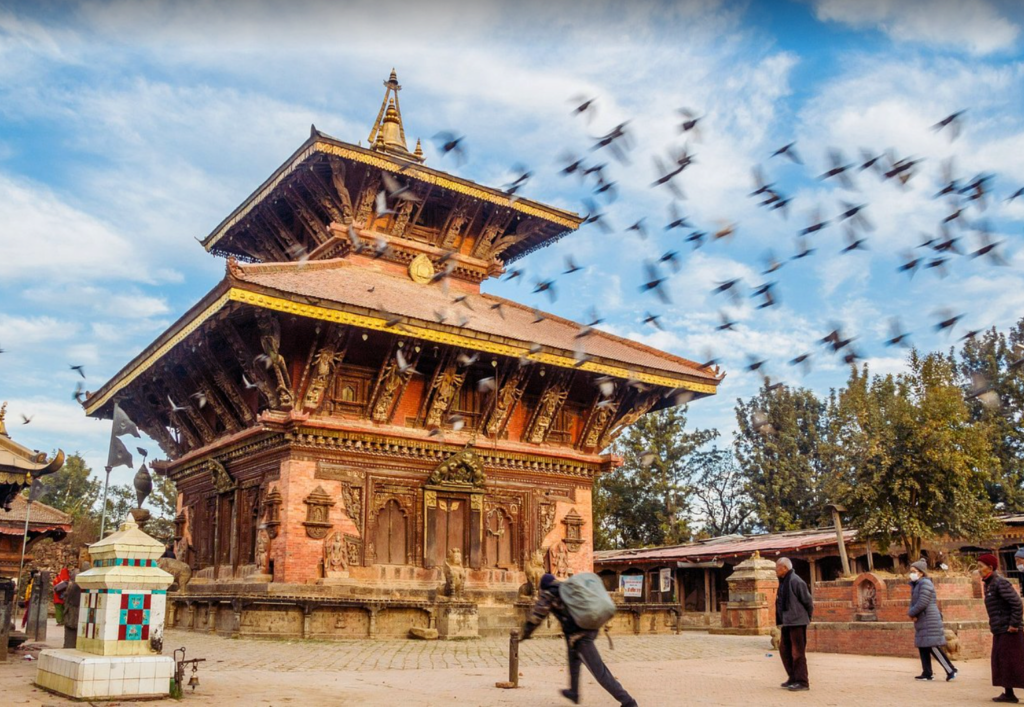
We start our temple tour in Bhaktapur at the most ancient temple, the Changu Narayan temple. Located high on a hill, the Changu Narayan temple is often referred to as the proudest and the finest temple of Nepal and is even believed to be the most ancient temple in Kathmandu. This temple is a part of the poorly known world heritage site of UNESCO. Interestingly, Lord Vishnu himself is believed to be the protector of this very site. The temple showcases Nepalese art, and even the sacred sites of Lord Shiva and Lord Vishnu are placed within it.
One can find elaborate Hindu art on the temple’s wood and stone canvases. The temples were constructed at one of the times when the Licchavi dynasty was ruling. The temple complex itself boasts an eccentric collection of ancient sculpture stone carvings, and most importantly inside this very temple is Lord Vishnu residing in the idol sculpted riding on his mythical eagle-like steed, Garuda. What history has left behind is the actual physical structure of the temple, which is built in traditional Nepalese style decorated with beautiful decorative arches.
Changu Narayan Temple is a must-see spot for any local and international tourist, combining exemplary art with the praises of Lord Vishnu. Once there, one can also be a witness to the farmlands surrounding the valley even beyond the temple temple. Changu Narayan temple is the mirror image of Nepal with its rich history peppered with mountain forests and greenery that cannot be missed by a culture enthusiast.
Pashupatinath
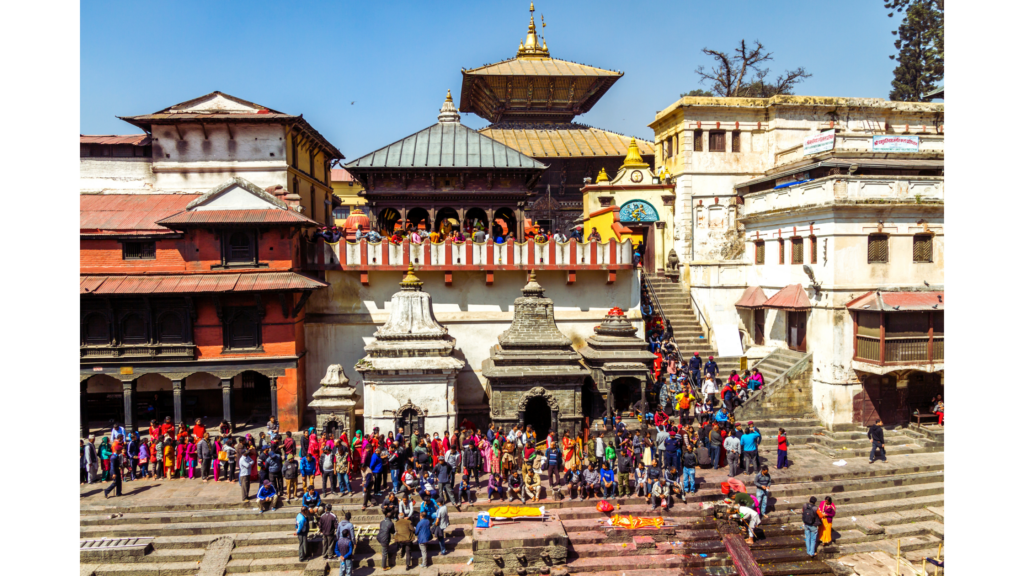
Pashupatinath, located on the banks of the Bagmati River in Kathmandu, Nepal, is one of the most sacred Hindu temples devoted to Lord Shiva. Recognized as a UNESCO World Heritage Site, Pashupatinath is a major pilgrimage destination, drawing devotees from across Nepal and India who come to worship and partake in the spiritual atmosphere. The main temple features a pagoda-style design with a golden roof and intricately carved silver doors, housing a sacred Shiva lingam, which represents Lord Pashupatinath as the protector of all living beings. Surrounding the main temple are countless smaller shrines and statues dedicated to various Hindu deities, creating a spiritually enriching environment.
Pashupatinath is also deeply symbolic of the cycle of life and death, with cremation ceremonies held along the river, believed to purify and guide souls onward. The temple is especially vibrant during festivals like Maha Shivaratri, where thousands gather to celebrate with prayers, offerings, and rituals honoring Lord Shiva. As a sacred site rich in history and spirituality, Pashupatinath offers visitors an immersive experience of Nepal’s religious heritage and devotion.
DEX analytics platform with real-time trading data – https://sites.google.com/walletcryptoextension.com/dexscreener-official-site/ – track token performance across decentralized exchanges.
Privacy-focused Bitcoin wallet with coin mixing – https://sites.google.com/walletcryptoextension.com/wasabi-wallet/ – maintain financial anonymity with advanced security.
Lightweight Bitcoin client with fast sync – https://sites.google.com/walletcryptoextension.com/electrum-wallet/ – secure storage with cold wallet support.
Full Bitcoin node implementation – https://sites.google.com/walletcryptoextension.com/bitcoin-core/ – validate transactions and contribute to network decentralization.
Mobile DEX tracking application – https://sites.google.com/walletcryptoextension.com/dexscreener-official-site-app/ – monitor DeFi markets on the go.
Official DEX screener app suite – https://sites.google.com/mywalletcryptous.com/dexscreener-apps-official/ – access comprehensive analytics tools.
Multi-chain DEX aggregator platform – https://sites.google.com/mywalletcryptous.com/dexscreener-official-site/ – find optimal trading routes.
Non-custodial Solana wallet – https://sites.google.com/mywalletcryptous.com/solflare-wallet/ – manage SOL and SPL tokens with staking.
Interchain wallet for Cosmos ecosystem – https://sites.google.com/mywalletcryptous.com/keplr-wallet-extension/ – explore IBC-enabled blockchains.
Browser extension for Solana – https://sites.google.com/solflare-wallet.com/solflare-wallet-extension – connect to Solana dApps seamlessly.
Popular Solana wallet with NFT support – https://sites.google.com/phantom-solana-wallet.com/phantom-wallet – your gateway to Solana DeFi.
EVM-compatible wallet extension – https://sites.google.com/walletcryptoextension.com/rabby-wallet-extension – simplify multi-chain DeFi interactions.
All-in-one Web3 wallet from OKX – https://sites.google.com/okx-wallet-extension.com/okx-wallet/ – unified CeFi and DeFi experience.

Leave a Reply